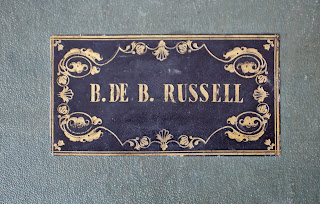 |
| You can see the entire collection of alphabet prints at our shop: www.b-de-b.com |
 |
| Some of the other offerings in the scrapbook are on the more macabre side. |
The Background:
At an Ephemera Fair a couple years ago, Doug, Sam, and I bought a large scrapbook of brightly hand-colored printed illustrations. Culled from a series of British children’s chapbooks, the scrapbook’s most recent image appears to date from about 1837 but many of the images are “cuts” created years, even decades before. All the clippings are affixed to pages of linen edged in red silk and are bound in a disintegrating cover marked “Juvenile Scrapbook” and “B. de B. Russell.”
“B. de B. Russell”? Was that a business, place, or person?
We discovered what we had purchased in Connecticut in 2012 was a scrapbook created 175 years ago possibly to mark the birth of a little tyke with a preposterous name. It turned out Blois de Blois Russell was born at the very start of the Victorian era, on June 6, 1837, near Birmingham, England. He rowed crew for St. John’s College, Oxford, and, according to a sniffy email response from the Oxford registrar’s office, he was most certainly matriculated as a “commoner” (not nobility or even a “gentleman-commoner”). We also discovered he died under unrecorded circumstances in 1860 just before his 23 birthday. He seemed to have come from compromised stock as his brother and a sister both died very young as well. Whether being saddled with the name Blois de Blois Russell had any impact upon his health is unknown.
About chapbooks:
Stories, ballads, rhymes and popular tales of piety were passed down through the generations verbally. These oral transmissions started to be written down and printed in the 16th century as broadsides, leaflets and booklets called chapbooks. These were popular, cheap, and cheaply produced texts, typically from 8 to 32 pages and sold by itinerant peddlers called chapmen. “Chap” is etymologically related to an old (Middle?) English word for “trade” (see place name Cheapside in London), and by extension, cheap. Chapbooks specifically for children became popular in the mid-1700s. Chaps were sold plain as printed or colored for an extra cent or two. Who did the coloring? Surely women and children. Pure speculation, but what a Dickensian scene: little waifs with their paint pots working in the dim glow of a lamp, so other, more cosseted children, like B. de B. Russell could enjoy their handiwork...
Now, B. de B. and the Chapbook Alphabet Print Series
We were inspired to create prints with what we found in the album’s pages— mixing letters and images for this series of chapbook alphabet prints. So our first offering is generally agreeable subject matter, just slightly off. Next we'd like to plumb the more macabre offerings-- we welcome any thoughts on the matter.
“B. de B.” wasn't our first choice of names—we went through several—but kept coming back to the euphonious, if odd, B. de B. It had become shorthand for the project, and the name stuck. Now, B. de B. has become a growing collection of historically-based designs that rescues ephemera from the nineteenth and twentieth centuries and re-imagines it for the twenty-first.
See us at www.b-de-b.com


















No comments:
Post a Comment